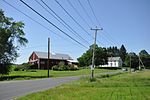Mount Nonotuck

Mount Nonotuck, 827 feet (252 m), is the northernmost peak of the Mount Tom Range of traprock mountains located in the Connecticut River Valley of Massachusetts and part of the larger Metacomet Ridge which stretches from Long Island Sound to nearly the Vermont border. Rugged and considered scenic, the peak rises steeply from the river valley 700 feet (210 m) below. It is located within the town of Holyoke.The 110-mile (180 km) Metacomet-Monadnock Trail, maintained by the Berkshire Chapter of the Appalachian Mountain Club, crosses Mt. Nonotuck, and a seasonal auto road (closed to vehicles indefinitely due to deteriorating conditions, hikers still welcome) climbs to a small parking lot just beneath the summit. During the winter, the auto road is often used for cross country skiing.
Excerpt from the Wikipedia article Mount Nonotuck (License: CC BY-SA 3.0, Authors, Images).Mount Nonotuck
Christopher Clark Road, Holyoke
Geographical coordinates (GPS) Address Nearby Places Show on map
Geographical coordinates (GPS)
| Latitude | Longitude |
|---|---|
| N 42.28 ° | E -72.620277777778 ° |
Address
Eyrie House
Christopher Clark Road
01061 Holyoke
Massachusetts, United States
Open on Google Maps








